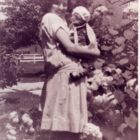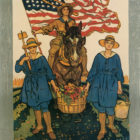By 1774 Ann Lee and her small band of Shaking Quakers had found their situation in England increasingly unstable. Considered suspect by local authorities, they were regularly followed, arrested, and imprisoned for civil disorder. While sitting in jail, yet again, Ann finally decided the time had come to sail to America. But why? Most of us today look backward through time and see the Shaker exodus as an escape from religious persecution, leaving the old world behind to found a new religion in the freedom loving wilderness of upstate New York. But those who lived in 1774 did not have our perspective. They had just barely survived 200 years of dramatic religious and military upheaval as 1000 years of ecclesiastical authority and ancient traditions were overthrown. By the 1700s, Europe breathed a collective sigh of relief. Monarchs regained control over their people and wars were, once again, fought for the traditional reasons of honor and land rather than faith. A more modern acceptance for some Christian diversity now transformed the old social landscape, and a more rational understanding of human existence coursed through Europe’s veins. This is the world from which the English Shakers emerged, but the story of their flight to America begins in the Protestant Reformation.
On October 31, 1517, Martin Luther, that strong willed German monk, posted his 95 arguments against the Catholic Church, ushering in the Reformation. Declaring Faith and Scripture alone as necessary for Christian salvation, Luther’s rejection of papal authority opened the floodgates for an increasingly varied array of personal revelations and Christian beliefs, including the Shakers. Aided by the newly emergent printing press, and a growing humanist unease at the worldly ambitions of Renaissance popes, Luther’s ideas quickly spread. Most Christian rulers strongly condemned these heretical Lutherans; rightly fearing that, if the pope’s supremacy could be toppled, what would stop a king’s subjects from someday condemning their own divinely crowned ruler? Chaos, anarchy, and civil war would surely follow.

In 1520, King Henry VIII, himself destined for a church career until his older brother’s untimely death made him king of England, wrote a strongly worded, public rebuttal to Luther’s dangerous blasphemies, earning the Tudor monarch the title, Defender of the Faith, from a grateful Pope Leo X. Within a decade, however, King Henry’s loyalty to the See of Rome began to waver. In 1527, spurred on by his need for a male heir, and his passionate love for the Lady Anne Boleyn, Henry decided to secretly ask the pope to annul his marriage to Katherine of Aragon so he could marry Anne. Henry had no reason to doubt Pope Clement VII would be sympathetic to his cause. Popes frequently understood these matters if the plaintiff, as Henry had surely proven, were loyal sons of the church. Unfortunately, Henry Tudor had not counted on his wife’s anger nor had he anticipated her nephew, King Charles of Spain, would come to his aunt’s rescue. When Henry’s ambassadors reached Rome in May of 1527, they found, much to their horror, the Spanish army had sacked the city, and taken the pope hostage. Few popes, and certainly not Pope Clement VII, would issue an annulment to a king whose in-laws were holding a proverbial knife to his throat.
Henry and Anne’s dreams of a quick wedding were dashed, and as the divorce stalemate between Henry and his first wife dragged on for years, the frustrated English king began to find Luther’s theology more attractive. By 1533, the king’s Parliament had made English appeals to the pope treasonable offenses, and Henry’s Archbishop of Canterbury, England’s highest ecclesiastic official, then boldly pronounced the king’s first marriage to Katherine of Aragon null and void, and the king’s secret marriage to Anne Boleyn, true and just. Anne Boleyn was crowned Queen of England on June 1, 1533 and gave birth to their daughter, Princess Elizabeth, that September. Anne’s coronation marks the formal break with Rome, and the beginnings of the Protestant Church of England. Henry Tudor took the church wealth, titled himself Supreme Head of the Church of England, and mandated his subjects pledge the Oath of Supremacy to him as head of both church and state, under pain of death. King Henry VIII had his way.
When their daughter, Elizabeth came to the throne in 1558, she inherited her father’s church. Queen Elizabeth expanded its Protestant doctrine, and strengthened the crown’s role as enforcer, making the Church of England and the English state one.

The church she designed, later known as the Episcopalian Church on this side of the Atlantic, mirrored her belief that Catholics and Protestants could peacefully co-exist if presented with a national religious identity they could both tolerate. And so Elizabeth accepted some Catholic traditions amidst an essentially Protestant theology. The queen preferred to impose stiff monetary fines on those who refused to attend, rather than utilize the deadly treason laws enacted by her father. Famously stating, “I have no desire to make windows into men’s souls,” the queen’s long reign and astute religious policies created a new English national identity, uniting temporally and spiritually a beloved sovereign and her people.
Queen Elizabeth had wisely predicted that, despite the imminent threat Catholic Europe posed to her Protestant realm in this era of religious wars, the greater threat to England’s Protestant throne would someday come from a small, but growing group of radical English Protestants derisively called Puritans. These Calvinists ardently desired a world governed by the religious moral codes they, as God’s Elect, believed righteous. Should their present ruler fail this task, Puritans believed they had a right to replace that ruler with their own. Speaking from the floor of Parliament, some Puritans dared chastise the queen for her failure to sweep away all remaining Catholic remnants. Elizabeth responded to her dangerous critics—who also had the temerity to suggest she, although queen, was still a mere woman who should not interfere with the religious matters of men—with arrest and imprisonment.
Elizabeth’s successors, the Stuart kings, were the first to truly experience this radical Puritan revolution. In 1649, Charles I of England became the first anointed king to be publicly executed by his people, ushering in ten years of Puritan rule known as The Commonwealth. When England willingly returned to Church of England and monarch in 1660, they vowed never again to allow such dangerous religious ideas to divide the bond between church, crown, and nation.
By the early 1700s, England had become a shining example of a tolerant, modern, constitutional monarchy. Parliament had tempered royal authority, but had also formally tied church to state and crown in its mandate that all future monarchs assume the role of Protestant head of the Church of England. England subjected its Catholic subjects to harsh penalties, but had begun to tolerate some Protestant Dissenter sects, provided they disavowed the Catholic Mass and took the Oath of Supremacy. English Baptists, Methodists, Presbyterians, and Quakers were amongst those accorded legal right to worship, although they, like their Catholic contemporaries, were forbidden entry to English universities, military and public offices.
Into this new world strode Ann Lee, who in 1758 joined a small Protestant sect presided over by James and Jane Wardley. Lee had been baptized and married in the Church of England, but her conviction that the Apocalypse was at hand created legal problems for local magistrates. By 1772, Manchester court records showed an increasing number of arrests and prison sentences meted out to Lee and her followers for disrupting Church of England services, and prophesying imminent doom should they fail to join Lee and her group.1 Not only did Lee and her followers disturb English spiritual peace with their proselytizing, but the very nature of their words; that the Church of England, encompassing king, Parliament, and country, was damned, smacked of treason. It is likely they also took advantage of these public outbursts to preach their doctrines of celibacy and private confession.2 As English officials saw it, this was not just some renegade Dissenter sect unlawfully criticizing church and state. Their apocalyptic prophesies also echoed the old, dangerous, Puritan call to arms against the state. And, to make matters even worse, Shakers embraced the Catholic practice of confession as well! One can understand, from the Manchester constable’s point of view, why he employed 24 men to firmly apprehend five Shakers when they entered the Anglican Church. And why Ann’s prison sentences grew longer as she continued to disrupt the peace. And why, finally, in 1774 she decided to move her fledgling group to New York, where many eager colonists were already fermenting another treasonous revolt against the English crown. Or as we fondly call it, The American Revolution.
1. Stephen Stein, The Shaker Experience in America (New Haven: Yale University Press, 1992), 4-5 cites William Axon, “The Early Shakers in Manchester,” Manifesto 22 (1892), 193-194 as his source for the Records of the constables in Manchester.
2. Ibid., 16.









